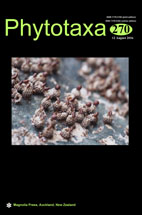Abstract
The validity of Zamia splendens has been debated, mainly as a result of its synonymy under Z. katzeriana. Field explorations have uncovered previously unknown populations, and some do not appear to match the circumscription of Z. katzeriana. Some populations are morphologically more similar to, and often sympatric with, Z. loddigesii. This study aims at clarifying the morphological and anatomical distinction between the three taxa. To study the morphological variation, a total of 88 individuals from four populations were sampled, these spanning the geographical range of the three cycads in southern Mexico. Univariate, principal component and discriminant analyses of 12 vegetative morphological variables were carried out. To study variation in leaflet anatomy, three individuals per population were analysed for nine anatomical variables and their stomatal index. Standard plant histological techniques and bright field light microscopy were used for observations and measurements of leaflet anatomical variables. Both morphological and anatomical variables were analysed by multivariate statistical methods. Principal component and discriminant analyses on both morphological and anatomical variables and the stomatal index have shown a significant difference between the populations (P = <0.0002) with scatter diagram dispersion indicating three distinctive groups, with Z. katzeriana values consistently intermediate between those of Z. splendens and Z. loddigesii. Some individuals of Z. katzeriana have a leaflet morphology and anatomy similar to Z. loddigesii, yet others resemble Z. splendens. The three taxa comprise distinct species and we propose the acceptance of Z. splendens as independent from Z. katzeriana. The intermediate placement of Z. katzeriana in the analyses suggests a hybrid origin with Z. splendens and Z. loddigesii as putative ancestors.

